
1
4th stage
طب مجتمع
Lec-3
د.نهى
8/12/2015
Investigating Epidemic
Learning Objective
Importance of investigating reported outbreaks
Steps in the investigation of an outbreak or epidemic
Describe epidemic curves
When the occurrence of adisease within an area is clearly in
excess of the expected level for a given time period, it is called
an epidemic. Public health officials often use the term
outbreak, which means the same thing, because it is less
provocative to the public. When an epidemic spreads over
several countries or continents, affecting a large number of
people, it is called a pandemic.
Why Investigate Possible Outbreaks?
Control/prevention
Research opportunities
Training
Public, political, or legal concerns
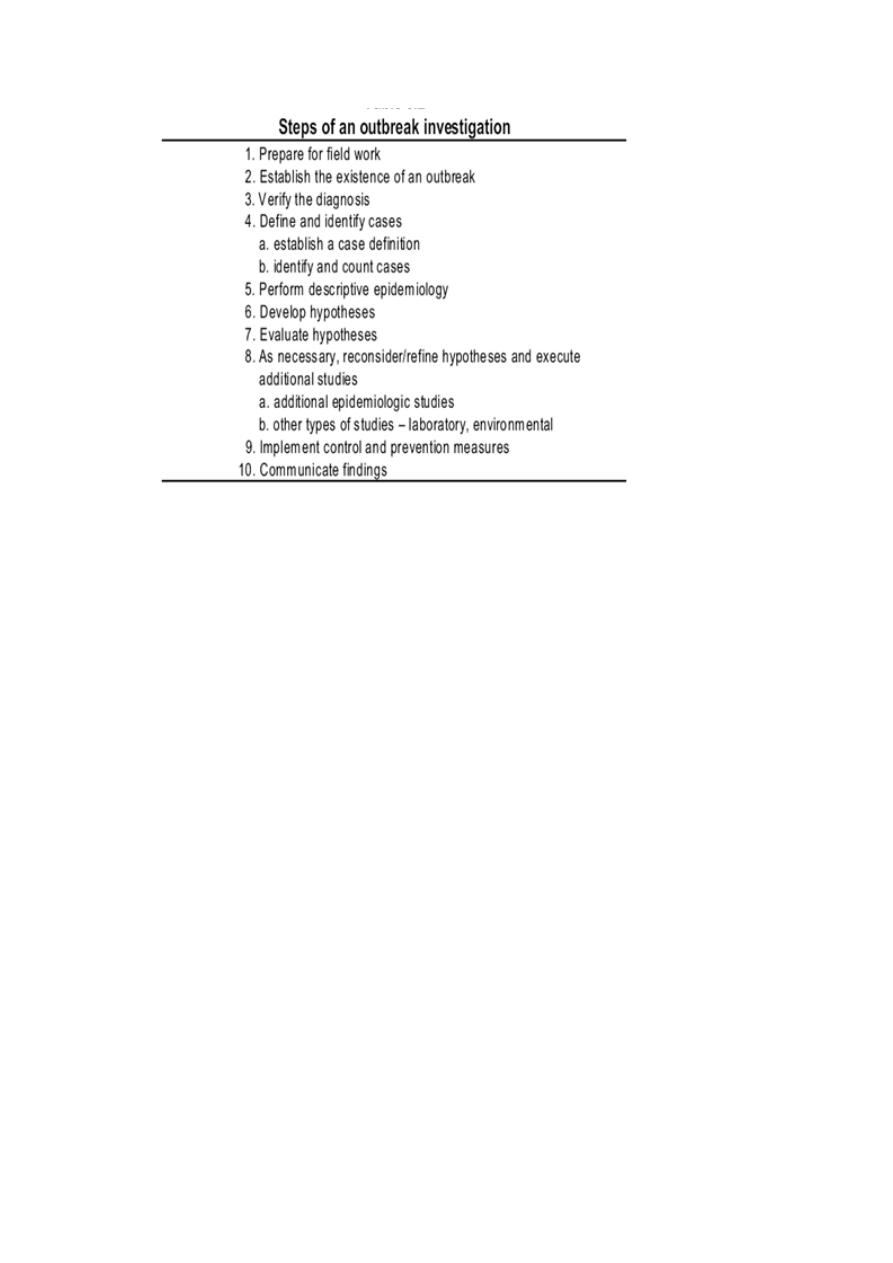
2
“Once a decision is made to investigate an outbreak, three
types of activities are generally involved
The epidemiologic investigation.
The environmental investigation.
The interaction with the public, the press, and, in many
instances, the legal system.”
Step 1:
Prepare for Fieldwork
Investigation
Administration
Consultation
Step 2:
Establishing the Existence
of an Outbreak
Is this an epidemic or cluster of cases?
Does the observed number exceed the expected number of
cases?

3
For a notifiable disease use health department surveillance
records.
For other diseases and conditions, find existing data locally—
hospital discharge records, mortality statistics, cancer or birth
defect registries.
If local data are not available, apply rates from neighboring
cities or national data, or, alternatively, conduct a telephone
survey of physicians to determine whether they have seen more
cases of the disease than usual.
Finally, conduct a survey of the community to establish the
background or historical level of disease.
Step 3:
Verifying the Diagnosis
to ensure that the problem has been properly diagnosed
to rule out laboratory error as the basis for the increase in
diagnosed cases.
summarize the clinical findings with frequency
distributions
Why?
Diseases can be misdiagnosed.
Case may not be actual case, but rather suspected case.
Information from non-cases must be excluded from the
case information used to confirm the presence or absence
of an epidemic.
Step 4a:
Establishing a Case Definition
A case definition is a standard set of criteria for deciding
whether an individual should be classified as having the health
condition of interest.
A case definition includes clinical criteria and--particularly in
the setting of an outbreak investigation--restrictions by time,
place and person.
Apply them consistently and without bias to all persons under
investigation.
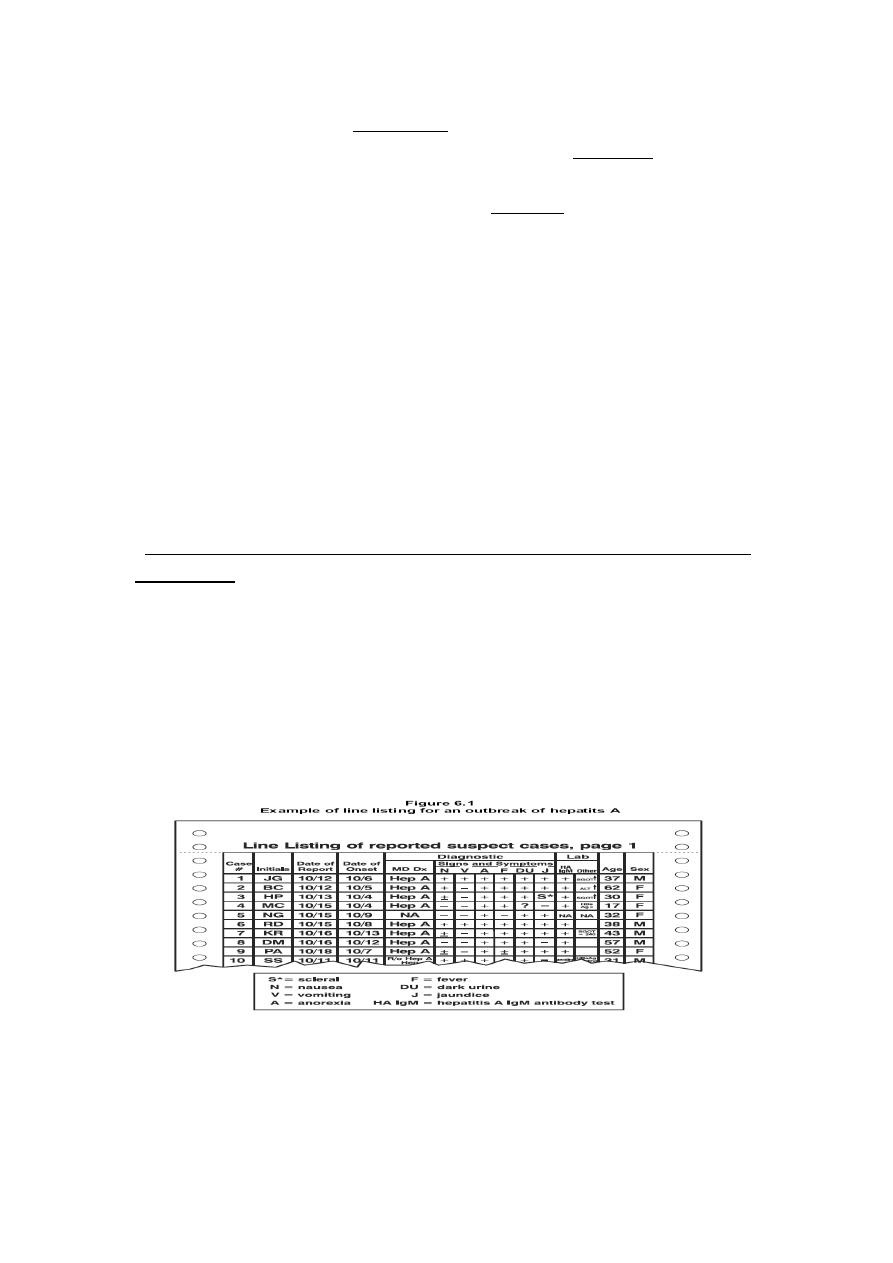
4
To be classified as confirmed, a case usually must have
laboratory verification. A case classified as probable usually has
typical clinical features of the disease without laboratory
confirmation. A case classified as possible usually has fewer of
the typical clinical features.
Step 4b:
Identifying and Counting Cases
Direct case finding at health care facilities where the diagnosis
is likely to be made: physicians , clinics, hospitals, and
laboratories.
In some outbreaks, public health officials may decide to alert
the public directly, usually through the local media.
Identifying contacts to case-patients .
Conduct a survey of the entire population.
The following items of information should be collected about
every case:
identifying information
demographic information
clinical information
risk factor information
reporter information
Develop a line listing:

5
Step 5:
Performing Descriptive Epidemiology
Characterize an outbreak by time, place, and person.
Why?
Provide a comprehensive description of an outbreak by
portraying :
- its trend over time,
- its geographic extent (place), and
- the populations (persons) affected by disease .
Assess description of the outbreak to develop causal
hypotheses
( in light of what is known ) :
- usual source,
- mode of transmission,
- risk factors and
- populations affected, etc.
Time
What is the exact period of the outbreak?
What is the probable period of exposure?
Is the outbreak likely common source or propagated?
Place
What is the most significant geographic distribution of cases?
Place of residence? Workplace?
What are the attack rates?

6
Person
What were the age and gender specific attack rates?
What age and gender groups are at highest and lowest risk of
illness?
In what other ways do the characteristics of the cases differ
significantly from those of the general population?
Interpreting an epidemic curve
Interpretation of the epidemic curve can prove to be very
helpful in determining the source of the outbreak.
Through review of the different patterns illustrated in an
epidemic curve, it is possible to hypothesize:
how an epidemic spread throughout a population
at what point you are in an epidemic
the diagnosis of the disease by establishing the potential
incubation period
When analyzing an epidemic curve, it is important to
consider the following factors
to assist in interpreting an outbreak:
the overall pattern of the epidemic
the time period when the persons were exposed
if there any outliers
Point Source
In a point source epidemic, persons are exposed to the same
exposure over a limited, defined period of time, usually within
one incubation period. The shape of this curve commonly
rises rapidly and contains a definite peak at the top, followed
by a gradual decline.
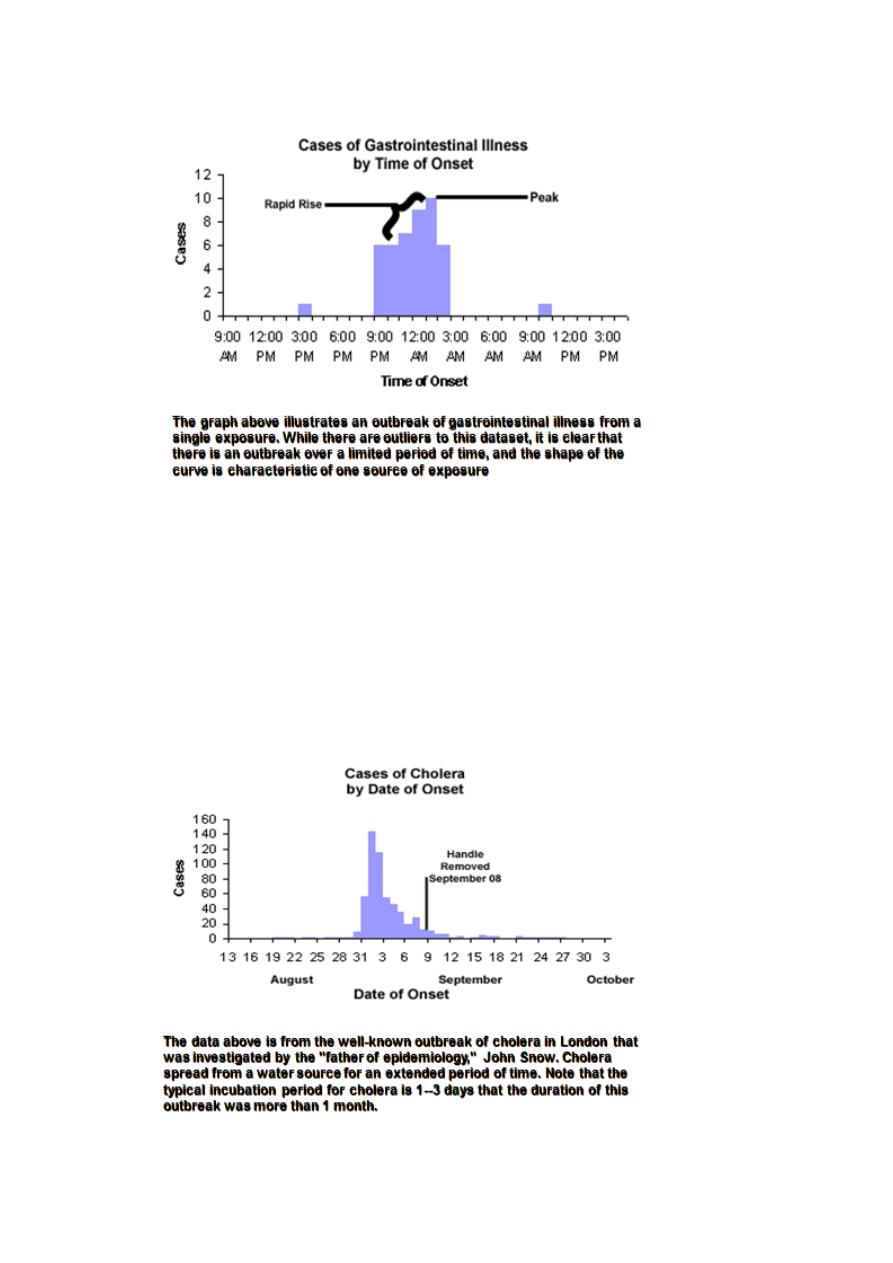
7
Continuous Common Source
exposure to the source is prolonged over an extended period of
time,
may occur over more than one incubation period,
The down slope of the curve may be very sharp if the common
source is removed, or
gradual if the outbreak is allowed to exhaust itself.
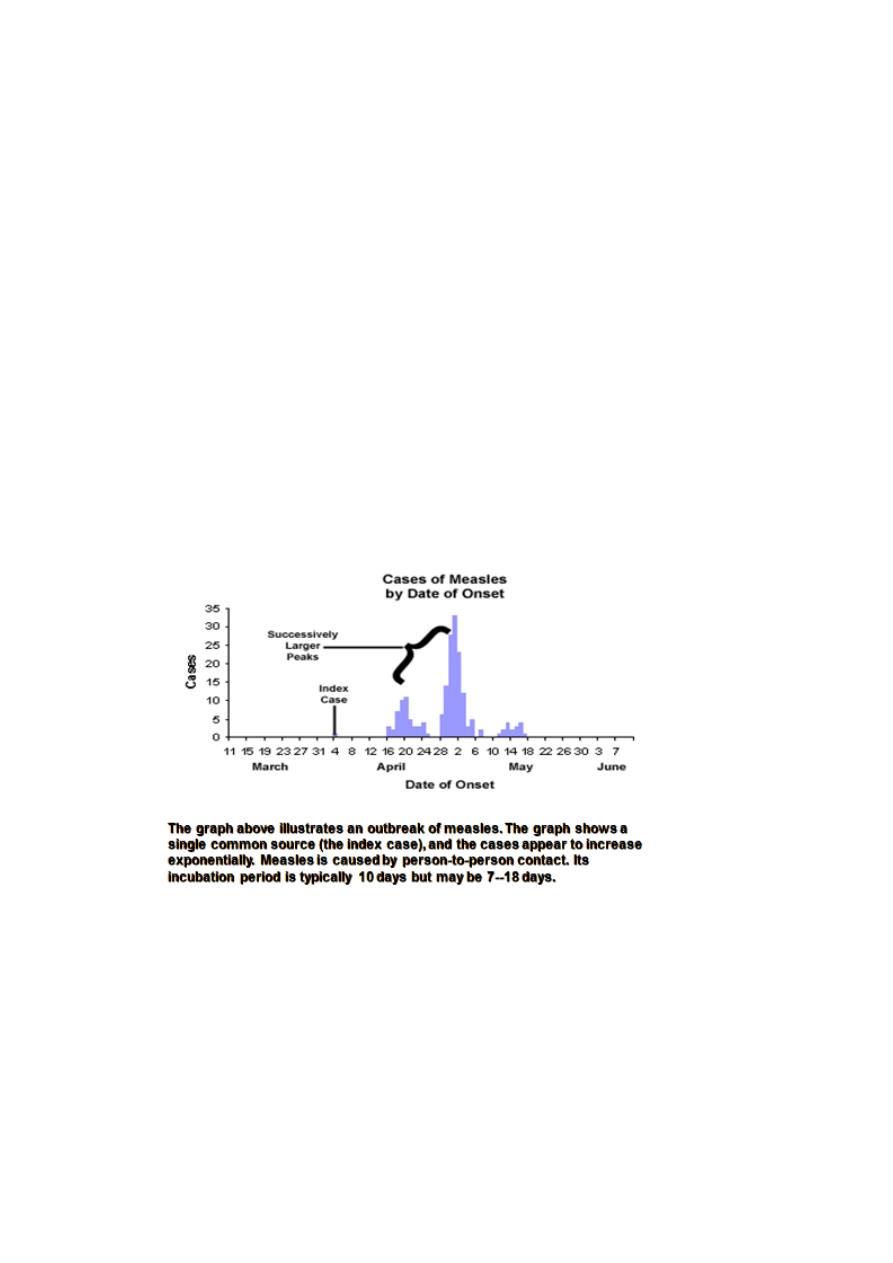
8
Propagated
(Progressive Source)
A propagated (progressive source) epidemic occurs when :
- a case of disease serves as a source of infection ,
- subsequent cases, in turn, serve as sources for later cases.
- The shape of the curve usually contains a series of successively
larger peaks,
( reflecting the increasing number of cases caused by person-to-
person contact ),
- This pattern may continue until the pool of susceptible is
exhausted or control measures are implemented.

9
Common Source Questions
Is the outbreak from a single source or common source?
Does the disease spread from person to person?
If there is a continued exposure to a single source?
Propagated Source
Questions:
Is the outbreak from multiple sources or exposures?
Is the outbreak airborne, behaviorally or chemically caused ,
and does it involve multiple events?
Are the sources of infection from inapparent sources?
Is there a vector or animal reservoir involved?
Duration of an epidemic
Is determined by:
The number of susceptible persons who are exposed to a source
of infection and become infected.
Period of time over which susceptible persons are exposed to
the source.
Minimum and maximum incubation periods for the disease.
Step 6:
Developing Hypotheses
All aspects of the investigation should be addressed:
- the source of the agent,
- the mode of transmission, (vehicle &vector),
- the exposures that caused the disease,
- any additional time, person, and place factors.
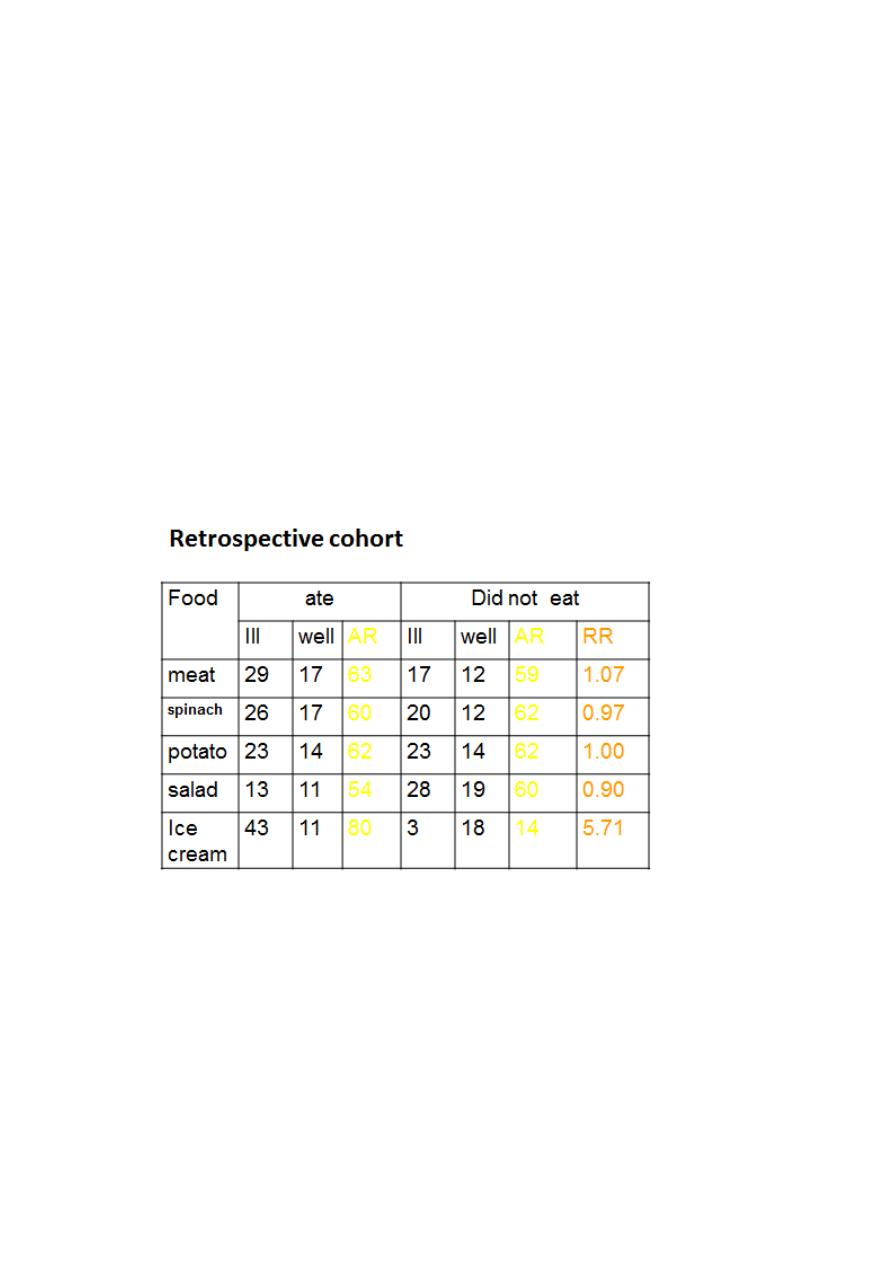
11
Step 7:
Evaluating Hypotheses
Either by comparing the hypotheses with the established facts,
or
by using analytic epidemiology to quantify relationships and
explore the role of chance.
Step 8:
Refining Hypotheses
and Executing
Additional Studies
Epidemiologic studies
Laboratory and environmental studies
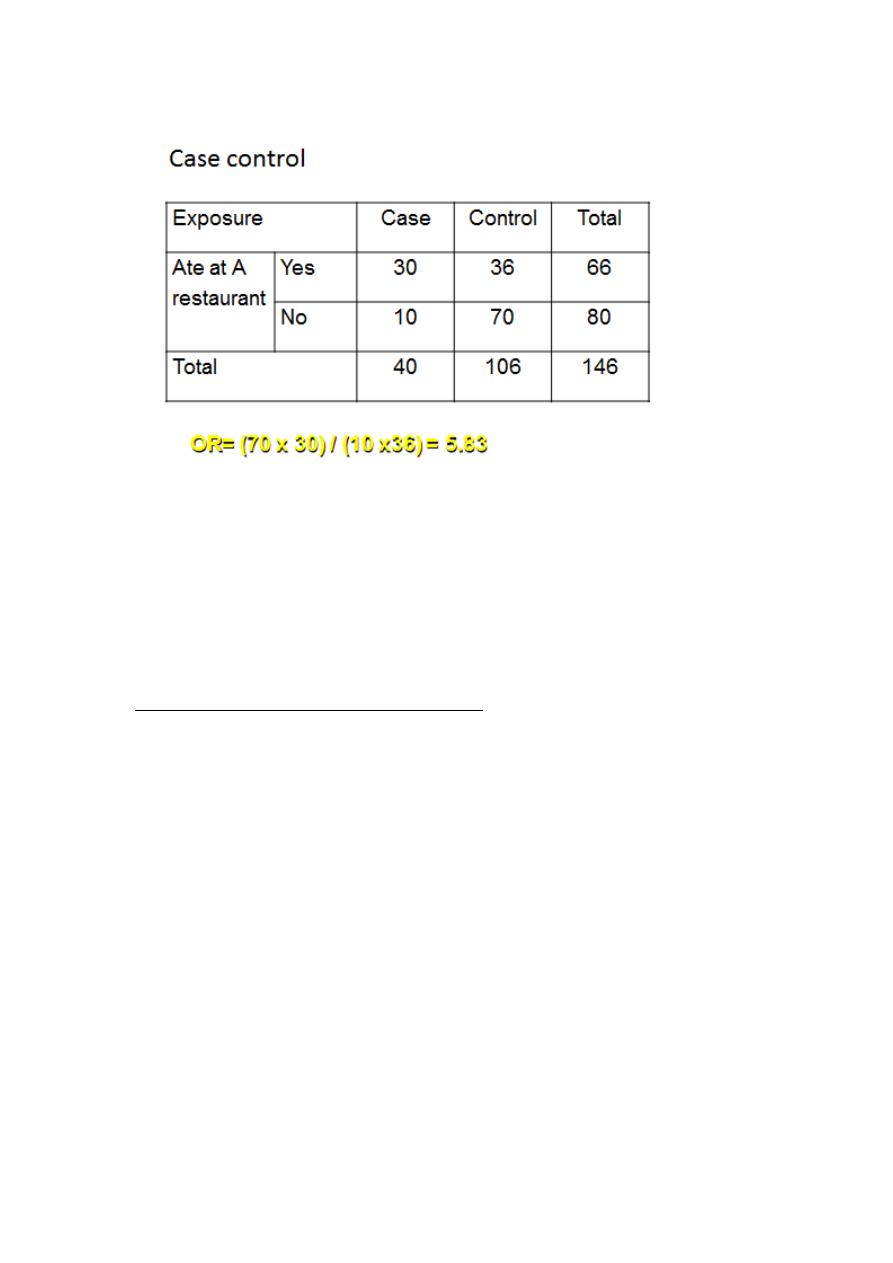
11
Step 9:
Implementing Control
and Prevention Measures
Aim to apply control measures at the weak link or links in the
chain of infection.
An outbreak might be controlled by :
- destroying contaminated foods,
- sterilizing contaminated water, or -
destroying mosquito breeding
sites.
“ An infectious food handler could be removed from the job
and treated.”

12
In other situations, control measures might be aimed at:
- interrupting transmission or
- reducing the exposure
(such as having nursing home residents with a particular
infection “cohorted,” or put together in a separate area to
prevent transmission to others).
In some outbreaks, control measures might be directed at:
- reducing the susceptibility of the host,
- Immunization ,
- chemoprophylaxis for travelers.
Step 10:
Communicating the Findings
1- an oral briefing for local authorities
and
2- a written scientific report.
